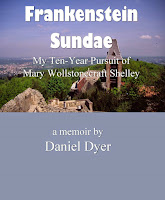During her
pre-Lodore period, Mary also did some
traveling (with her eleven-year-old son to Southend for about a month in the
summer of 1830. Now officially Southend-on-Sea, about forty miles due east of
London, at the mouth of the Thames in the North Sea (Google tells me a train
makes the journey in fifty-three minutes), the town was, for a while, a
fashionable resort (thanks to the train that arrived in the nineteenth
century). Mary had always loved the seaside, even though, now, it surely caused
her to tremble to be reminded—every day, in sound and sight—that this was the
sort of lovely water that had killed her husband.
Mary was
also visiting friends, writing reviews and stories, and, as a favor, reading
through the manuscript of Edward J. Trelawny’s memoir Adventures of a Younger Son, which would appear in 1831. In late
December 1830, Mary wrote to Trelawny, who was eager (impatient, even) for news
of her reaction. I am delighted with your
work, she began; it is full of
passion, energy & novelty—it concerns the sea & that is a subject of
the greatest interest to me—I should imagine that it should command success—
But she was
also fearful about some of what she read. She cautioned Trelawny about what she
perceived to be excessive frankness about women. And his overall diction. Certain words & phrases, she wrote, pardoned in the days of Fielding are now
justly interdicted—& any gross piece of ill taste will make your bookseller
draw back. … Besides that I, your partial [here, meaning special, biased in
your favor] friend, strongly object to
coarseness ….[1]
Their
correspondence about the manuscript would continue—and Mary would work hard
with London publishers to place his book (she succeeded), but Trelawny, never a
grateful man, grew somewhat bitter about Mary, doubting whether she was really
exerting her utmost for him. But in her letters, she seems to suggest that she
and Trelawny might marry! What ensues
is interesting, to say the least.


No comments:
Post a Comment